Impact of Climate Change on Marine Ecosystems: A Critical Analysis
VerifiedAdded on 2023/06/04
|23
|6370
|143
Report
AI Summary
This report critically analyzes the relationship between climate change and marine ecosystems, specifically focusing on the oceans. It begins by highlighting the anthropogenic causes of climate change, such as the emission of greenhouse gases, particularly carbon dioxide, and the resulting global warming. The paper then discusses the crucial role of oceans in absorbing excess atmospheric carbon dioxide and buffering heat, followed by an in-depth examination of the impacts of climate change on the marine environment. Key areas of focus include ocean acidification, warming, and the disruption of marine food chains. The report explores the physical and biological implications of acidification, including the calcification of oceanic organisms. Furthermore, it provides insights into adaptation and mitigation measures to address climate change and manage the oceans sustainably. The report emphasizes the interconnectedness of climate change and marine ecosystems, offering a comprehensive overview of the challenges and potential solutions.
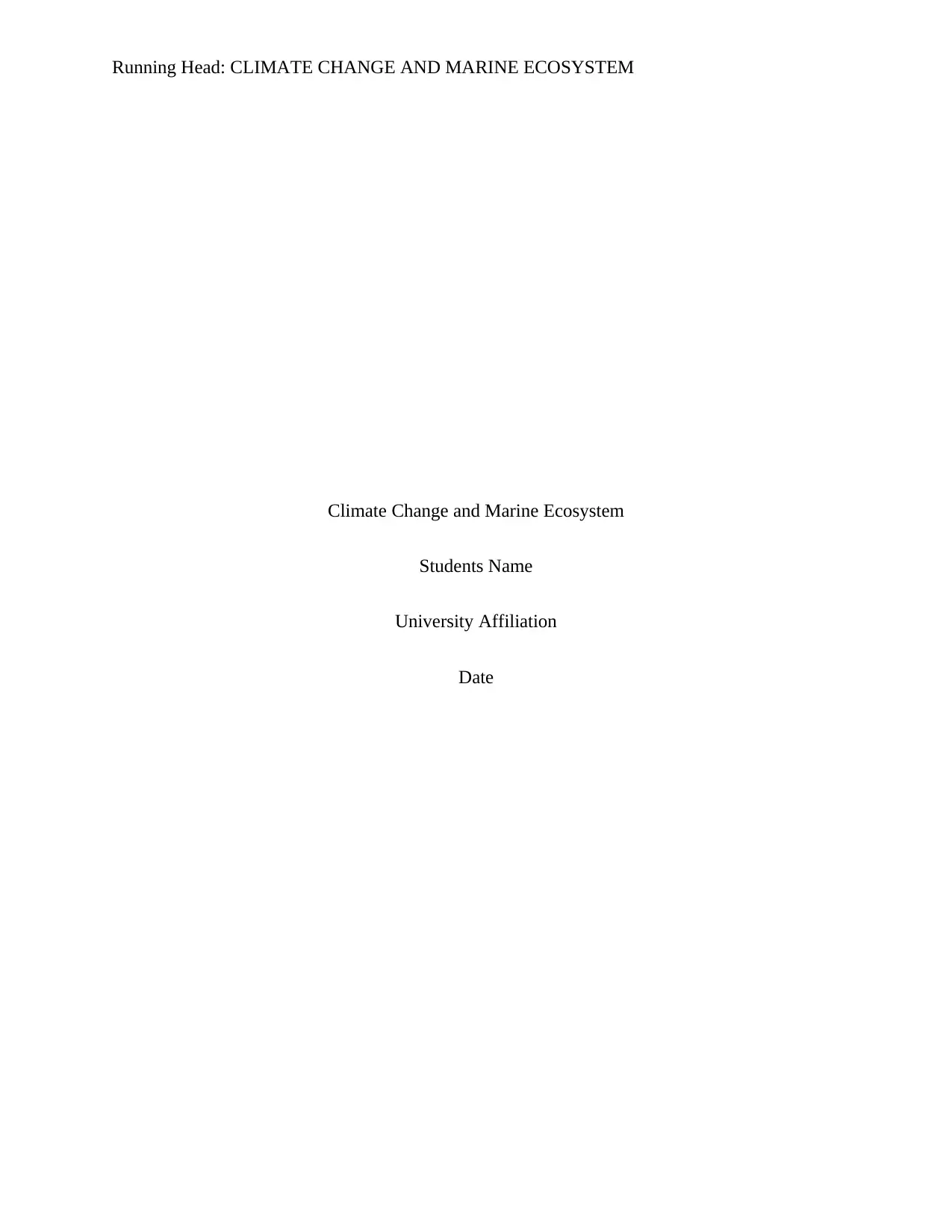
Running Head: CLIMATE CHANGE AND MARINE ECOSYSTEM
Climate Change and Marine Ecosystem
Students Name
University Affiliation
Date
Climate Change and Marine Ecosystem
Students Name
University Affiliation
Date
Paraphrase This Document
Need a fresh take? Get an instant paraphrase of this document with our AI Paraphraser
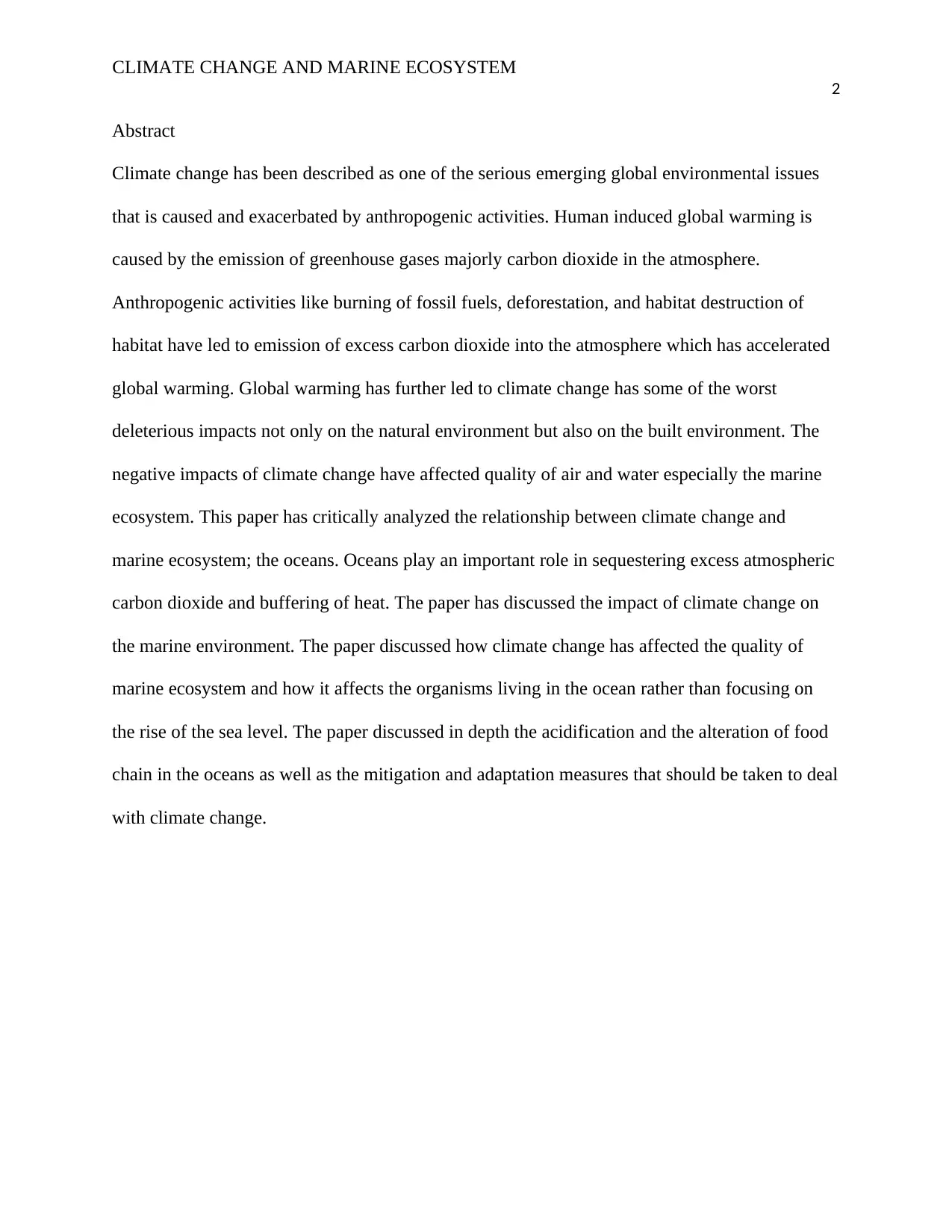
CLIMATE CHANGE AND MARINE ECOSYSTEM
2
Abstract
Climate change has been described as one of the serious emerging global environmental issues
that is caused and exacerbated by anthropogenic activities. Human induced global warming is
caused by the emission of greenhouse gases majorly carbon dioxide in the atmosphere.
Anthropogenic activities like burning of fossil fuels, deforestation, and habitat destruction of
habitat have led to emission of excess carbon dioxide into the atmosphere which has accelerated
global warming. Global warming has further led to climate change has some of the worst
deleterious impacts not only on the natural environment but also on the built environment. The
negative impacts of climate change have affected quality of air and water especially the marine
ecosystem. This paper has critically analyzed the relationship between climate change and
marine ecosystem; the oceans. Oceans play an important role in sequestering excess atmospheric
carbon dioxide and buffering of heat. The paper has discussed the impact of climate change on
the marine environment. The paper discussed how climate change has affected the quality of
marine ecosystem and how it affects the organisms living in the ocean rather than focusing on
the rise of the sea level. The paper discussed in depth the acidification and the alteration of food
chain in the oceans as well as the mitigation and adaptation measures that should be taken to deal
with climate change.
2
Abstract
Climate change has been described as one of the serious emerging global environmental issues
that is caused and exacerbated by anthropogenic activities. Human induced global warming is
caused by the emission of greenhouse gases majorly carbon dioxide in the atmosphere.
Anthropogenic activities like burning of fossil fuels, deforestation, and habitat destruction of
habitat have led to emission of excess carbon dioxide into the atmosphere which has accelerated
global warming. Global warming has further led to climate change has some of the worst
deleterious impacts not only on the natural environment but also on the built environment. The
negative impacts of climate change have affected quality of air and water especially the marine
ecosystem. This paper has critically analyzed the relationship between climate change and
marine ecosystem; the oceans. Oceans play an important role in sequestering excess atmospheric
carbon dioxide and buffering of heat. The paper has discussed the impact of climate change on
the marine environment. The paper discussed how climate change has affected the quality of
marine ecosystem and how it affects the organisms living in the ocean rather than focusing on
the rise of the sea level. The paper discussed in depth the acidification and the alteration of food
chain in the oceans as well as the mitigation and adaptation measures that should be taken to deal
with climate change.

CLIMATE CHANGE AND MARINE ECOSYSTEM
3
Table of content
Contents
Abstract.......................................................................................................................................................2
Table of content...........................................................................................................................................3
Climate Change and Marine Ecosystem......................................................................................................4
Introduction.............................................................................................................................................4
The Ocean, Climate Change and The People...............................................................................................5
The Climate and The Ocean........................................................................................................................7
Ocean Acidification and The Climate Change.............................................................................................8
Warming of the Ocean.............................................................................................................................8
Ocean Acidification and Climate Change................................................................................................9
Physical Environmental Impacts of Ocean Acidification...................................................................10
Biological Implication of Acidification.............................................................................................11
Calcification of the Oceanic Organisms....................................................................................................12
Climate Change and The Marine Food Chain............................................................................................13
Adaptation and Mitigation of Climate Change as well as the Management of the Ocean..........................16
Conclusion.................................................................................................................................................18
References.................................................................................................................................................19
3
Table of content
Contents
Abstract.......................................................................................................................................................2
Table of content...........................................................................................................................................3
Climate Change and Marine Ecosystem......................................................................................................4
Introduction.............................................................................................................................................4
The Ocean, Climate Change and The People...............................................................................................5
The Climate and The Ocean........................................................................................................................7
Ocean Acidification and The Climate Change.............................................................................................8
Warming of the Ocean.............................................................................................................................8
Ocean Acidification and Climate Change................................................................................................9
Physical Environmental Impacts of Ocean Acidification...................................................................10
Biological Implication of Acidification.............................................................................................11
Calcification of the Oceanic Organisms....................................................................................................12
Climate Change and The Marine Food Chain............................................................................................13
Adaptation and Mitigation of Climate Change as well as the Management of the Ocean..........................16
Conclusion.................................................................................................................................................18
References.................................................................................................................................................19
⊘ This is a preview!⊘
Do you want full access?
Subscribe today to unlock all pages.

Trusted by 1+ million students worldwide
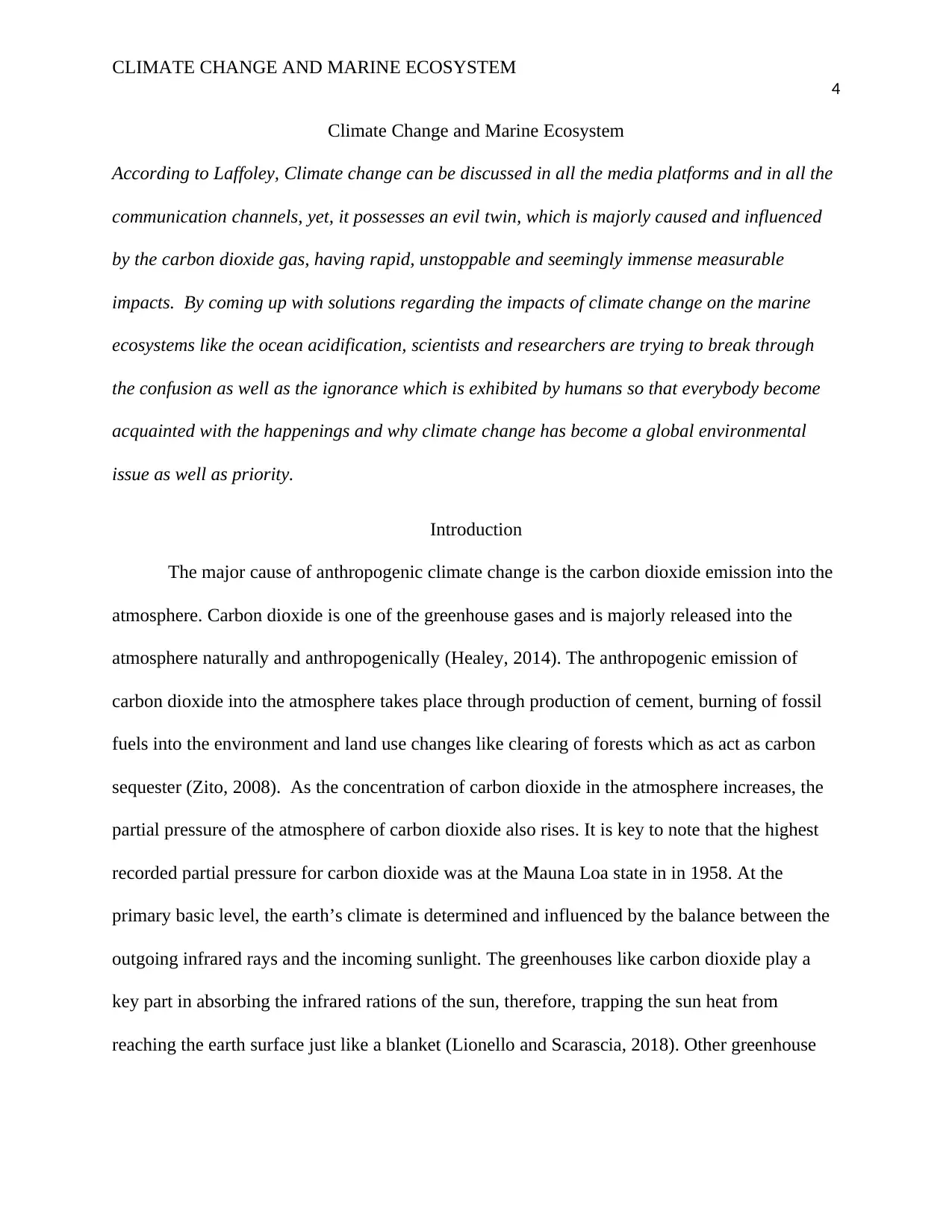
CLIMATE CHANGE AND MARINE ECOSYSTEM
4
Climate Change and Marine Ecosystem
According to Laffoley, Climate change can be discussed in all the media platforms and in all the
communication channels, yet, it possesses an evil twin, which is majorly caused and influenced
by the carbon dioxide gas, having rapid, unstoppable and seemingly immense measurable
impacts. By coming up with solutions regarding the impacts of climate change on the marine
ecosystems like the ocean acidification, scientists and researchers are trying to break through
the confusion as well as the ignorance which is exhibited by humans so that everybody become
acquainted with the happenings and why climate change has become a global environmental
issue as well as priority.
Introduction
The major cause of anthropogenic climate change is the carbon dioxide emission into the
atmosphere. Carbon dioxide is one of the greenhouse gases and is majorly released into the
atmosphere naturally and anthropogenically (Healey, 2014). The anthropogenic emission of
carbon dioxide into the atmosphere takes place through production of cement, burning of fossil
fuels into the environment and land use changes like clearing of forests which as act as carbon
sequester (Zito, 2008). As the concentration of carbon dioxide in the atmosphere increases, the
partial pressure of the atmosphere of carbon dioxide also rises. It is key to note that the highest
recorded partial pressure for carbon dioxide was at the Mauna Loa state in in 1958. At the
primary basic level, the earth’s climate is determined and influenced by the balance between the
outgoing infrared rays and the incoming sunlight. The greenhouses like carbon dioxide play a
key part in absorbing the infrared rations of the sun, therefore, trapping the sun heat from
reaching the earth surface just like a blanket (Lionello and Scarascia, 2018). Other greenhouse
4
Climate Change and Marine Ecosystem
According to Laffoley, Climate change can be discussed in all the media platforms and in all the
communication channels, yet, it possesses an evil twin, which is majorly caused and influenced
by the carbon dioxide gas, having rapid, unstoppable and seemingly immense measurable
impacts. By coming up with solutions regarding the impacts of climate change on the marine
ecosystems like the ocean acidification, scientists and researchers are trying to break through
the confusion as well as the ignorance which is exhibited by humans so that everybody become
acquainted with the happenings and why climate change has become a global environmental
issue as well as priority.
Introduction
The major cause of anthropogenic climate change is the carbon dioxide emission into the
atmosphere. Carbon dioxide is one of the greenhouse gases and is majorly released into the
atmosphere naturally and anthropogenically (Healey, 2014). The anthropogenic emission of
carbon dioxide into the atmosphere takes place through production of cement, burning of fossil
fuels into the environment and land use changes like clearing of forests which as act as carbon
sequester (Zito, 2008). As the concentration of carbon dioxide in the atmosphere increases, the
partial pressure of the atmosphere of carbon dioxide also rises. It is key to note that the highest
recorded partial pressure for carbon dioxide was at the Mauna Loa state in in 1958. At the
primary basic level, the earth’s climate is determined and influenced by the balance between the
outgoing infrared rays and the incoming sunlight. The greenhouses like carbon dioxide play a
key part in absorbing the infrared rations of the sun, therefore, trapping the sun heat from
reaching the earth surface just like a blanket (Lionello and Scarascia, 2018). Other greenhouse
Paraphrase This Document
Need a fresh take? Get an instant paraphrase of this document with our AI Paraphraser
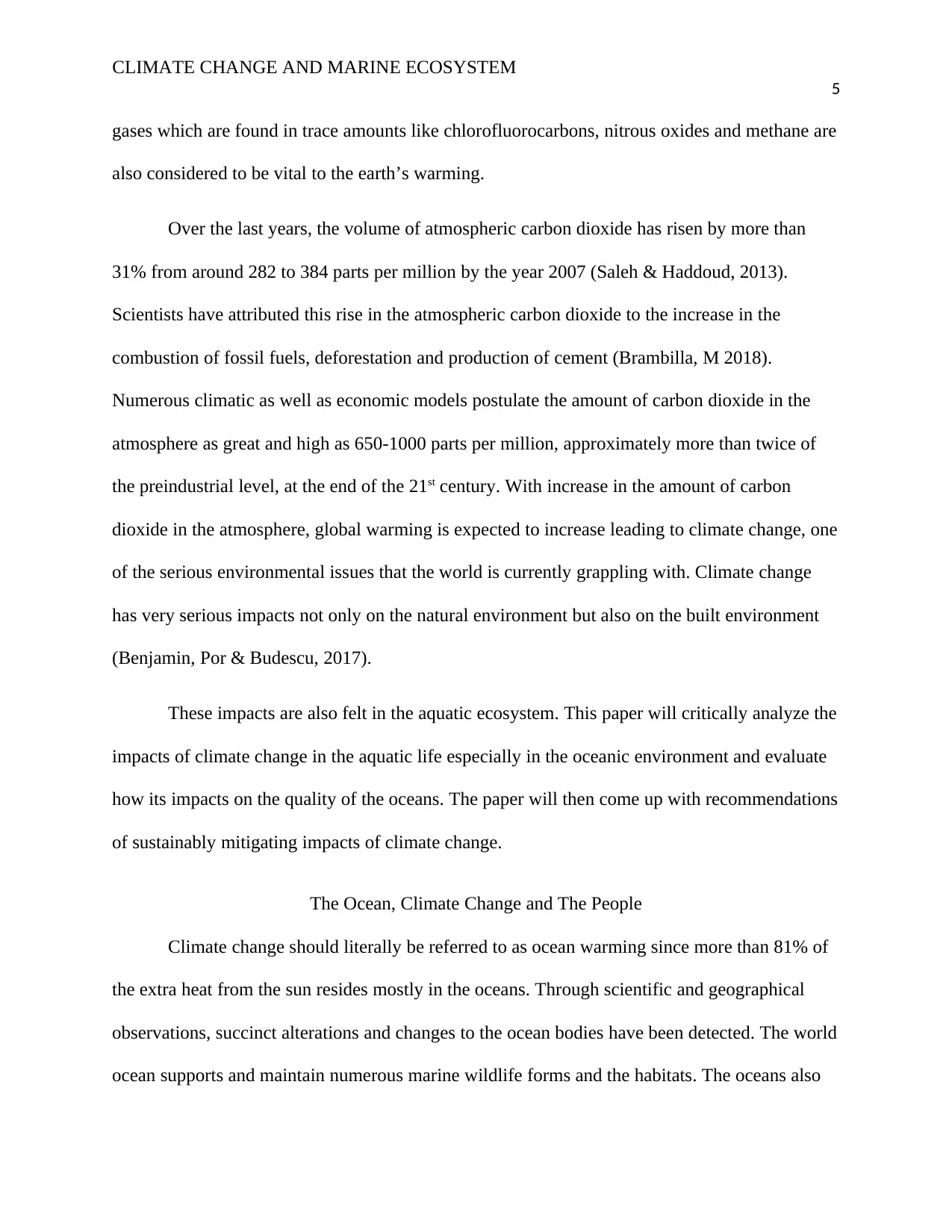
CLIMATE CHANGE AND MARINE ECOSYSTEM
5
gases which are found in trace amounts like chlorofluorocarbons, nitrous oxides and methane are
also considered to be vital to the earth’s warming.
Over the last years, the volume of atmospheric carbon dioxide has risen by more than
31% from around 282 to 384 parts per million by the year 2007 (Saleh & Haddoud, 2013).
Scientists have attributed this rise in the atmospheric carbon dioxide to the increase in the
combustion of fossil fuels, deforestation and production of cement (Brambilla, M 2018).
Numerous climatic as well as economic models postulate the amount of carbon dioxide in the
atmosphere as great and high as 650-1000 parts per million, approximately more than twice of
the preindustrial level, at the end of the 21st century. With increase in the amount of carbon
dioxide in the atmosphere, global warming is expected to increase leading to climate change, one
of the serious environmental issues that the world is currently grappling with. Climate change
has very serious impacts not only on the natural environment but also on the built environment
(Benjamin, Por & Budescu, 2017).
These impacts are also felt in the aquatic ecosystem. This paper will critically analyze the
impacts of climate change in the aquatic life especially in the oceanic environment and evaluate
how its impacts on the quality of the oceans. The paper will then come up with recommendations
of sustainably mitigating impacts of climate change.
The Ocean, Climate Change and The People
Climate change should literally be referred to as ocean warming since more than 81% of
the extra heat from the sun resides mostly in the oceans. Through scientific and geographical
observations, succinct alterations and changes to the ocean bodies have been detected. The world
ocean supports and maintain numerous marine wildlife forms and the habitats. The oceans also
5
gases which are found in trace amounts like chlorofluorocarbons, nitrous oxides and methane are
also considered to be vital to the earth’s warming.
Over the last years, the volume of atmospheric carbon dioxide has risen by more than
31% from around 282 to 384 parts per million by the year 2007 (Saleh & Haddoud, 2013).
Scientists have attributed this rise in the atmospheric carbon dioxide to the increase in the
combustion of fossil fuels, deforestation and production of cement (Brambilla, M 2018).
Numerous climatic as well as economic models postulate the amount of carbon dioxide in the
atmosphere as great and high as 650-1000 parts per million, approximately more than twice of
the preindustrial level, at the end of the 21st century. With increase in the amount of carbon
dioxide in the atmosphere, global warming is expected to increase leading to climate change, one
of the serious environmental issues that the world is currently grappling with. Climate change
has very serious impacts not only on the natural environment but also on the built environment
(Benjamin, Por & Budescu, 2017).
These impacts are also felt in the aquatic ecosystem. This paper will critically analyze the
impacts of climate change in the aquatic life especially in the oceanic environment and evaluate
how its impacts on the quality of the oceans. The paper will then come up with recommendations
of sustainably mitigating impacts of climate change.
The Ocean, Climate Change and The People
Climate change should literally be referred to as ocean warming since more than 81% of
the extra heat from the sun resides mostly in the oceans. Through scientific and geographical
observations, succinct alterations and changes to the ocean bodies have been detected. The world
ocean supports and maintain numerous marine wildlife forms and the habitats. The oceans also
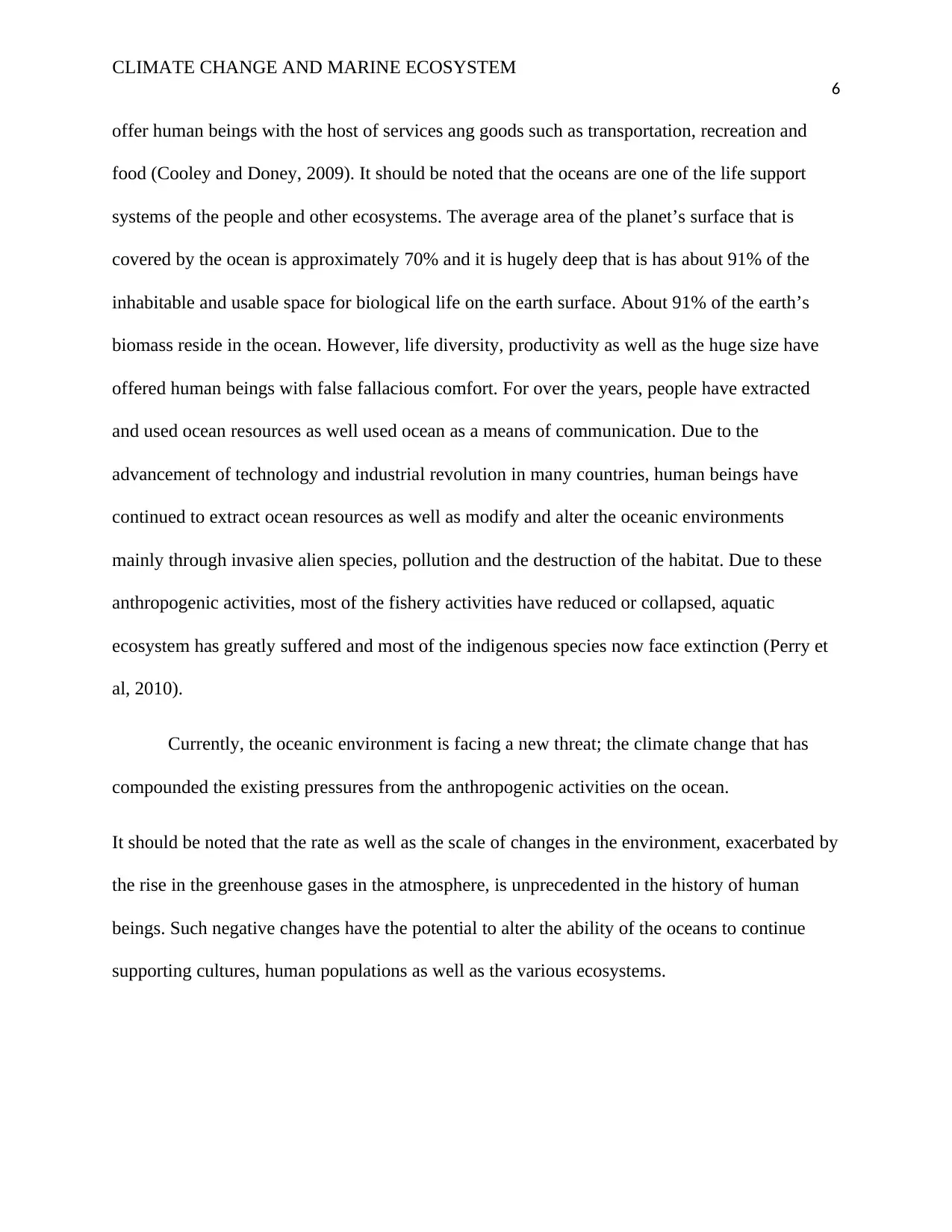
CLIMATE CHANGE AND MARINE ECOSYSTEM
6
offer human beings with the host of services ang goods such as transportation, recreation and
food (Cooley and Doney, 2009). It should be noted that the oceans are one of the life support
systems of the people and other ecosystems. The average area of the planet’s surface that is
covered by the ocean is approximately 70% and it is hugely deep that is has about 91% of the
inhabitable and usable space for biological life on the earth surface. About 91% of the earth’s
biomass reside in the ocean. However, life diversity, productivity as well as the huge size have
offered human beings with false fallacious comfort. For over the years, people have extracted
and used ocean resources as well used ocean as a means of communication. Due to the
advancement of technology and industrial revolution in many countries, human beings have
continued to extract ocean resources as well as modify and alter the oceanic environments
mainly through invasive alien species, pollution and the destruction of the habitat. Due to these
anthropogenic activities, most of the fishery activities have reduced or collapsed, aquatic
ecosystem has greatly suffered and most of the indigenous species now face extinction (Perry et
al, 2010).
Currently, the oceanic environment is facing a new threat; the climate change that has
compounded the existing pressures from the anthropogenic activities on the ocean.
It should be noted that the rate as well as the scale of changes in the environment, exacerbated by
the rise in the greenhouse gases in the atmosphere, is unprecedented in the history of human
beings. Such negative changes have the potential to alter the ability of the oceans to continue
supporting cultures, human populations as well as the various ecosystems.
6
offer human beings with the host of services ang goods such as transportation, recreation and
food (Cooley and Doney, 2009). It should be noted that the oceans are one of the life support
systems of the people and other ecosystems. The average area of the planet’s surface that is
covered by the ocean is approximately 70% and it is hugely deep that is has about 91% of the
inhabitable and usable space for biological life on the earth surface. About 91% of the earth’s
biomass reside in the ocean. However, life diversity, productivity as well as the huge size have
offered human beings with false fallacious comfort. For over the years, people have extracted
and used ocean resources as well used ocean as a means of communication. Due to the
advancement of technology and industrial revolution in many countries, human beings have
continued to extract ocean resources as well as modify and alter the oceanic environments
mainly through invasive alien species, pollution and the destruction of the habitat. Due to these
anthropogenic activities, most of the fishery activities have reduced or collapsed, aquatic
ecosystem has greatly suffered and most of the indigenous species now face extinction (Perry et
al, 2010).
Currently, the oceanic environment is facing a new threat; the climate change that has
compounded the existing pressures from the anthropogenic activities on the ocean.
It should be noted that the rate as well as the scale of changes in the environment, exacerbated by
the rise in the greenhouse gases in the atmosphere, is unprecedented in the history of human
beings. Such negative changes have the potential to alter the ability of the oceans to continue
supporting cultures, human populations as well as the various ecosystems.
⊘ This is a preview!⊘
Do you want full access?
Subscribe today to unlock all pages.

Trusted by 1+ million students worldwide
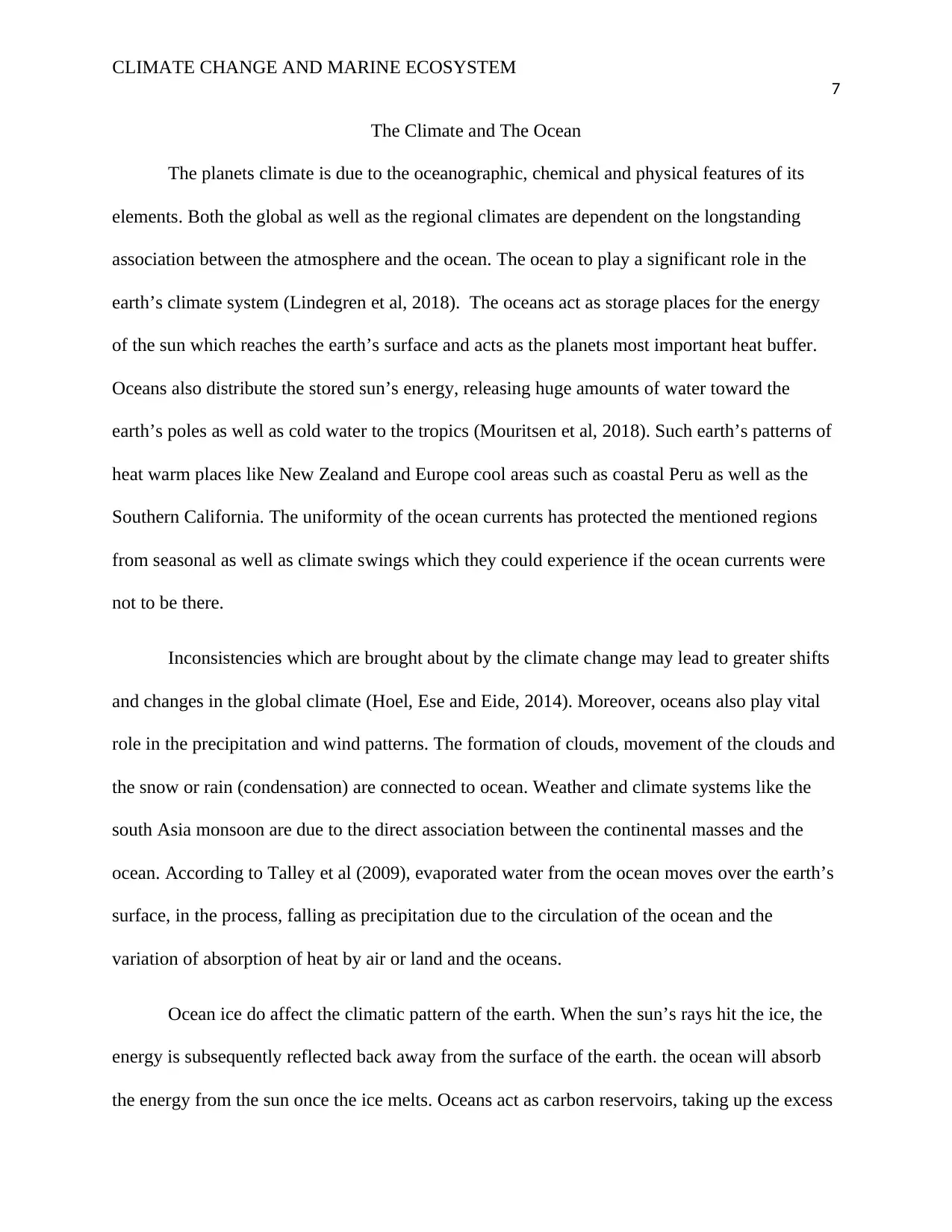
CLIMATE CHANGE AND MARINE ECOSYSTEM
7
The Climate and The Ocean
The planets climate is due to the oceanographic, chemical and physical features of its
elements. Both the global as well as the regional climates are dependent on the longstanding
association between the atmosphere and the ocean. The ocean to play a significant role in the
earth’s climate system (Lindegren et al, 2018). The oceans act as storage places for the energy
of the sun which reaches the earth’s surface and acts as the planets most important heat buffer.
Oceans also distribute the stored sun’s energy, releasing huge amounts of water toward the
earth’s poles as well as cold water to the tropics (Mouritsen et al, 2018). Such earth’s patterns of
heat warm places like New Zealand and Europe cool areas such as coastal Peru as well as the
Southern California. The uniformity of the ocean currents has protected the mentioned regions
from seasonal as well as climate swings which they could experience if the ocean currents were
not to be there.
Inconsistencies which are brought about by the climate change may lead to greater shifts
and changes in the global climate (Hoel, Ese and Eide, 2014). Moreover, oceans also play vital
role in the precipitation and wind patterns. The formation of clouds, movement of the clouds and
the snow or rain (condensation) are connected to ocean. Weather and climate systems like the
south Asia monsoon are due to the direct association between the continental masses and the
ocean. According to Talley et al (2009), evaporated water from the ocean moves over the earth’s
surface, in the process, falling as precipitation due to the circulation of the ocean and the
variation of absorption of heat by air or land and the oceans.
Ocean ice do affect the climatic pattern of the earth. When the sun’s rays hit the ice, the
energy is subsequently reflected back away from the surface of the earth. the ocean will absorb
the energy from the sun once the ice melts. Oceans act as carbon reservoirs, taking up the excess
7
The Climate and The Ocean
The planets climate is due to the oceanographic, chemical and physical features of its
elements. Both the global as well as the regional climates are dependent on the longstanding
association between the atmosphere and the ocean. The ocean to play a significant role in the
earth’s climate system (Lindegren et al, 2018). The oceans act as storage places for the energy
of the sun which reaches the earth’s surface and acts as the planets most important heat buffer.
Oceans also distribute the stored sun’s energy, releasing huge amounts of water toward the
earth’s poles as well as cold water to the tropics (Mouritsen et al, 2018). Such earth’s patterns of
heat warm places like New Zealand and Europe cool areas such as coastal Peru as well as the
Southern California. The uniformity of the ocean currents has protected the mentioned regions
from seasonal as well as climate swings which they could experience if the ocean currents were
not to be there.
Inconsistencies which are brought about by the climate change may lead to greater shifts
and changes in the global climate (Hoel, Ese and Eide, 2014). Moreover, oceans also play vital
role in the precipitation and wind patterns. The formation of clouds, movement of the clouds and
the snow or rain (condensation) are connected to ocean. Weather and climate systems like the
south Asia monsoon are due to the direct association between the continental masses and the
ocean. According to Talley et al (2009), evaporated water from the ocean moves over the earth’s
surface, in the process, falling as precipitation due to the circulation of the ocean and the
variation of absorption of heat by air or land and the oceans.
Ocean ice do affect the climatic pattern of the earth. When the sun’s rays hit the ice, the
energy is subsequently reflected back away from the surface of the earth. the ocean will absorb
the energy from the sun once the ice melts. Oceans act as carbon reservoirs, taking up the excess
Paraphrase This Document
Need a fresh take? Get an instant paraphrase of this document with our AI Paraphraser
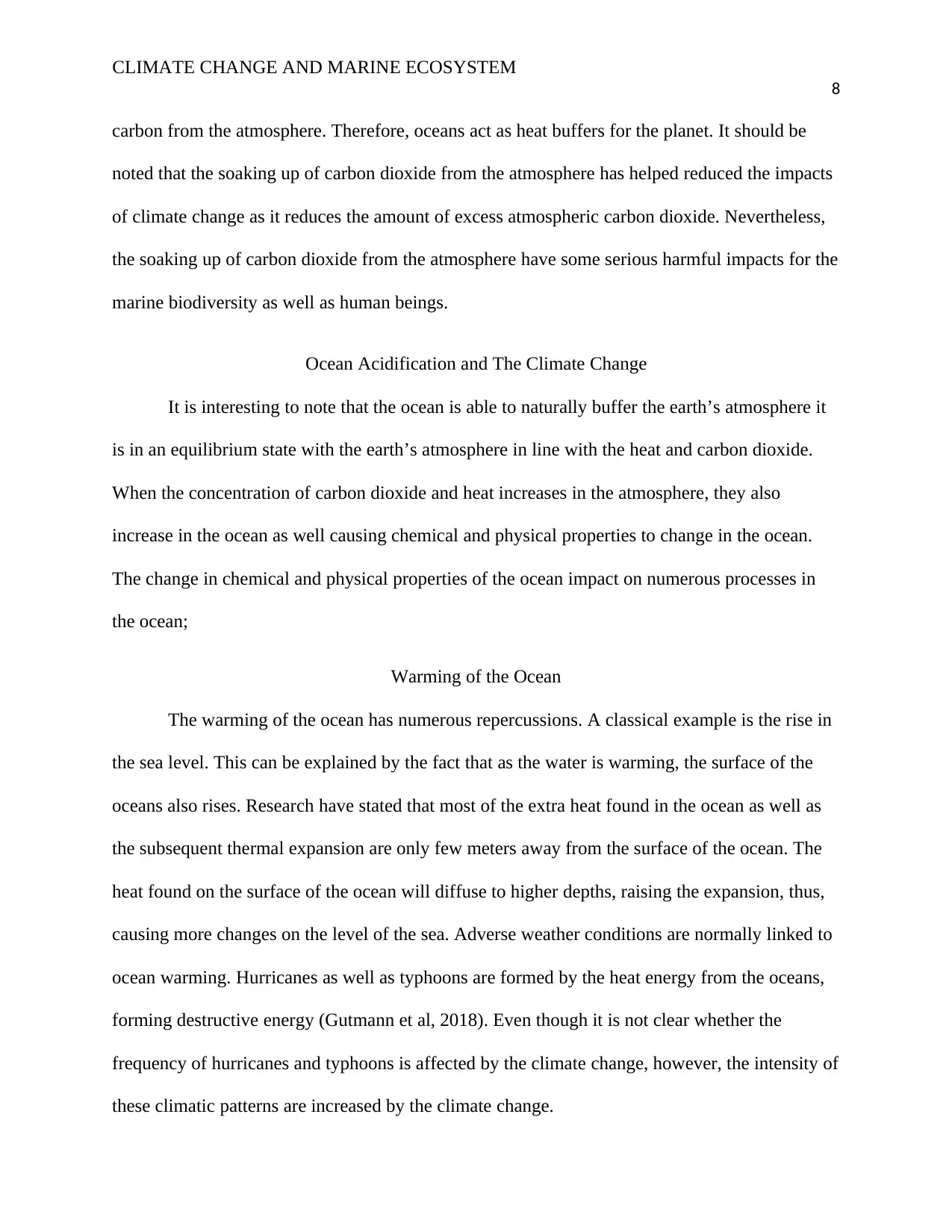
CLIMATE CHANGE AND MARINE ECOSYSTEM
8
carbon from the atmosphere. Therefore, oceans act as heat buffers for the planet. It should be
noted that the soaking up of carbon dioxide from the atmosphere has helped reduced the impacts
of climate change as it reduces the amount of excess atmospheric carbon dioxide. Nevertheless,
the soaking up of carbon dioxide from the atmosphere have some serious harmful impacts for the
marine biodiversity as well as human beings.
Ocean Acidification and The Climate Change
It is interesting to note that the ocean is able to naturally buffer the earth’s atmosphere it
is in an equilibrium state with the earth’s atmosphere in line with the heat and carbon dioxide.
When the concentration of carbon dioxide and heat increases in the atmosphere, they also
increase in the ocean as well causing chemical and physical properties to change in the ocean.
The change in chemical and physical properties of the ocean impact on numerous processes in
the ocean;
Warming of the Ocean
The warming of the ocean has numerous repercussions. A classical example is the rise in
the sea level. This can be explained by the fact that as the water is warming, the surface of the
oceans also rises. Research have stated that most of the extra heat found in the ocean as well as
the subsequent thermal expansion are only few meters away from the surface of the ocean. The
heat found on the surface of the ocean will diffuse to higher depths, raising the expansion, thus,
causing more changes on the level of the sea. Adverse weather conditions are normally linked to
ocean warming. Hurricanes as well as typhoons are formed by the heat energy from the oceans,
forming destructive energy (Gutmann et al, 2018). Even though it is not clear whether the
frequency of hurricanes and typhoons is affected by the climate change, however, the intensity of
these climatic patterns are increased by the climate change.
8
carbon from the atmosphere. Therefore, oceans act as heat buffers for the planet. It should be
noted that the soaking up of carbon dioxide from the atmosphere has helped reduced the impacts
of climate change as it reduces the amount of excess atmospheric carbon dioxide. Nevertheless,
the soaking up of carbon dioxide from the atmosphere have some serious harmful impacts for the
marine biodiversity as well as human beings.
Ocean Acidification and The Climate Change
It is interesting to note that the ocean is able to naturally buffer the earth’s atmosphere it
is in an equilibrium state with the earth’s atmosphere in line with the heat and carbon dioxide.
When the concentration of carbon dioxide and heat increases in the atmosphere, they also
increase in the ocean as well causing chemical and physical properties to change in the ocean.
The change in chemical and physical properties of the ocean impact on numerous processes in
the ocean;
Warming of the Ocean
The warming of the ocean has numerous repercussions. A classical example is the rise in
the sea level. This can be explained by the fact that as the water is warming, the surface of the
oceans also rises. Research have stated that most of the extra heat found in the ocean as well as
the subsequent thermal expansion are only few meters away from the surface of the ocean. The
heat found on the surface of the ocean will diffuse to higher depths, raising the expansion, thus,
causing more changes on the level of the sea. Adverse weather conditions are normally linked to
ocean warming. Hurricanes as well as typhoons are formed by the heat energy from the oceans,
forming destructive energy (Gutmann et al, 2018). Even though it is not clear whether the
frequency of hurricanes and typhoons is affected by the climate change, however, the intensity of
these climatic patterns are increased by the climate change.
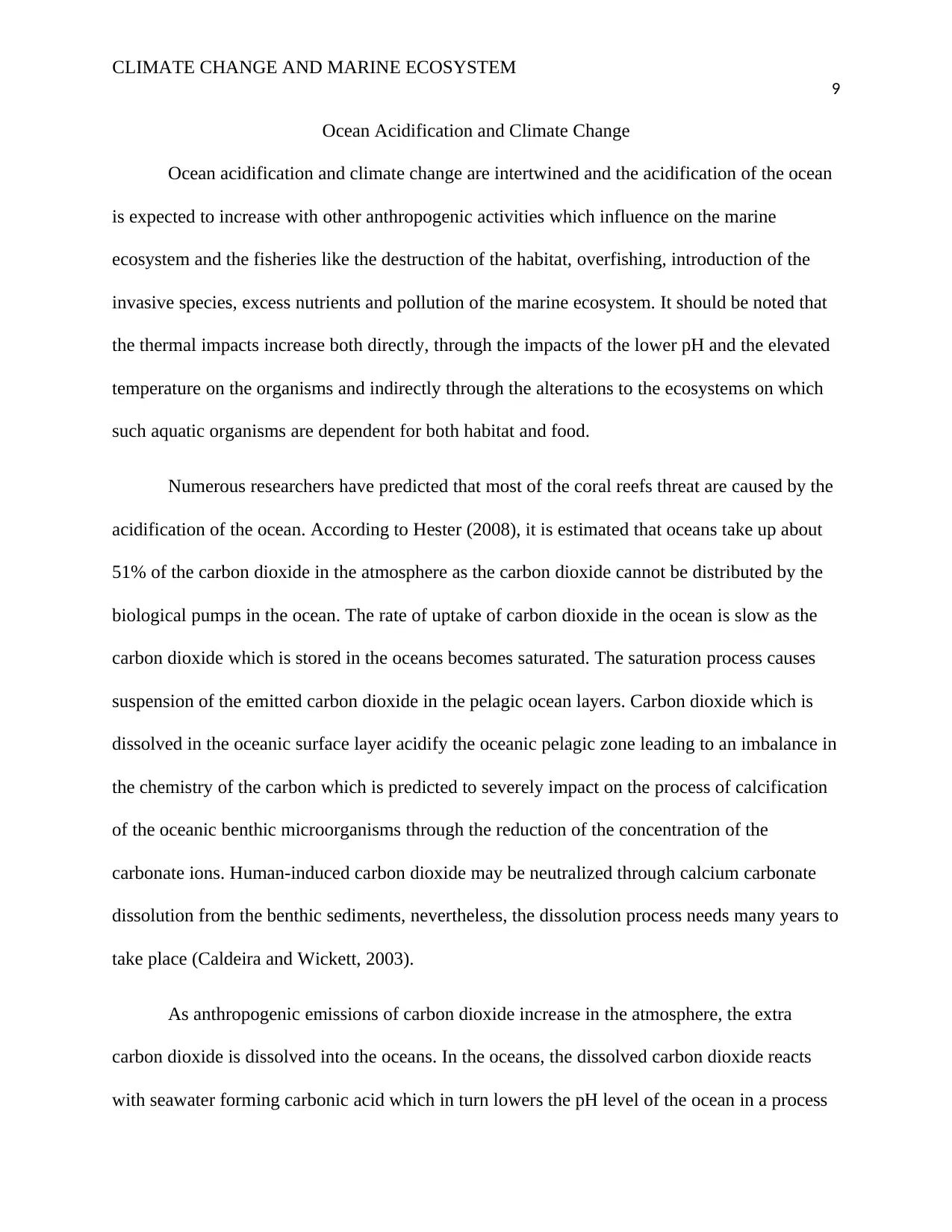
CLIMATE CHANGE AND MARINE ECOSYSTEM
9
Ocean Acidification and Climate Change
Ocean acidification and climate change are intertwined and the acidification of the ocean
is expected to increase with other anthropogenic activities which influence on the marine
ecosystem and the fisheries like the destruction of the habitat, overfishing, introduction of the
invasive species, excess nutrients and pollution of the marine ecosystem. It should be noted that
the thermal impacts increase both directly, through the impacts of the lower pH and the elevated
temperature on the organisms and indirectly through the alterations to the ecosystems on which
such aquatic organisms are dependent for both habitat and food.
Numerous researchers have predicted that most of the coral reefs threat are caused by the
acidification of the ocean. According to Hester (2008), it is estimated that oceans take up about
51% of the carbon dioxide in the atmosphere as the carbon dioxide cannot be distributed by the
biological pumps in the ocean. The rate of uptake of carbon dioxide in the ocean is slow as the
carbon dioxide which is stored in the oceans becomes saturated. The saturation process causes
suspension of the emitted carbon dioxide in the pelagic ocean layers. Carbon dioxide which is
dissolved in the oceanic surface layer acidify the oceanic pelagic zone leading to an imbalance in
the chemistry of the carbon which is predicted to severely impact on the process of calcification
of the oceanic benthic microorganisms through the reduction of the concentration of the
carbonate ions. Human-induced carbon dioxide may be neutralized through calcium carbonate
dissolution from the benthic sediments, nevertheless, the dissolution process needs many years to
take place (Caldeira and Wickett, 2003).
As anthropogenic emissions of carbon dioxide increase in the atmosphere, the extra
carbon dioxide is dissolved into the oceans. In the oceans, the dissolved carbon dioxide reacts
with seawater forming carbonic acid which in turn lowers the pH level of the ocean in a process
9
Ocean Acidification and Climate Change
Ocean acidification and climate change are intertwined and the acidification of the ocean
is expected to increase with other anthropogenic activities which influence on the marine
ecosystem and the fisheries like the destruction of the habitat, overfishing, introduction of the
invasive species, excess nutrients and pollution of the marine ecosystem. It should be noted that
the thermal impacts increase both directly, through the impacts of the lower pH and the elevated
temperature on the organisms and indirectly through the alterations to the ecosystems on which
such aquatic organisms are dependent for both habitat and food.
Numerous researchers have predicted that most of the coral reefs threat are caused by the
acidification of the ocean. According to Hester (2008), it is estimated that oceans take up about
51% of the carbon dioxide in the atmosphere as the carbon dioxide cannot be distributed by the
biological pumps in the ocean. The rate of uptake of carbon dioxide in the ocean is slow as the
carbon dioxide which is stored in the oceans becomes saturated. The saturation process causes
suspension of the emitted carbon dioxide in the pelagic ocean layers. Carbon dioxide which is
dissolved in the oceanic surface layer acidify the oceanic pelagic zone leading to an imbalance in
the chemistry of the carbon which is predicted to severely impact on the process of calcification
of the oceanic benthic microorganisms through the reduction of the concentration of the
carbonate ions. Human-induced carbon dioxide may be neutralized through calcium carbonate
dissolution from the benthic sediments, nevertheless, the dissolution process needs many years to
take place (Caldeira and Wickett, 2003).
As anthropogenic emissions of carbon dioxide increase in the atmosphere, the extra
carbon dioxide is dissolved into the oceans. In the oceans, the dissolved carbon dioxide reacts
with seawater forming carbonic acid which in turn lowers the pH level of the ocean in a process
⊘ This is a preview!⊘
Do you want full access?
Subscribe today to unlock all pages.

Trusted by 1+ million students worldwide
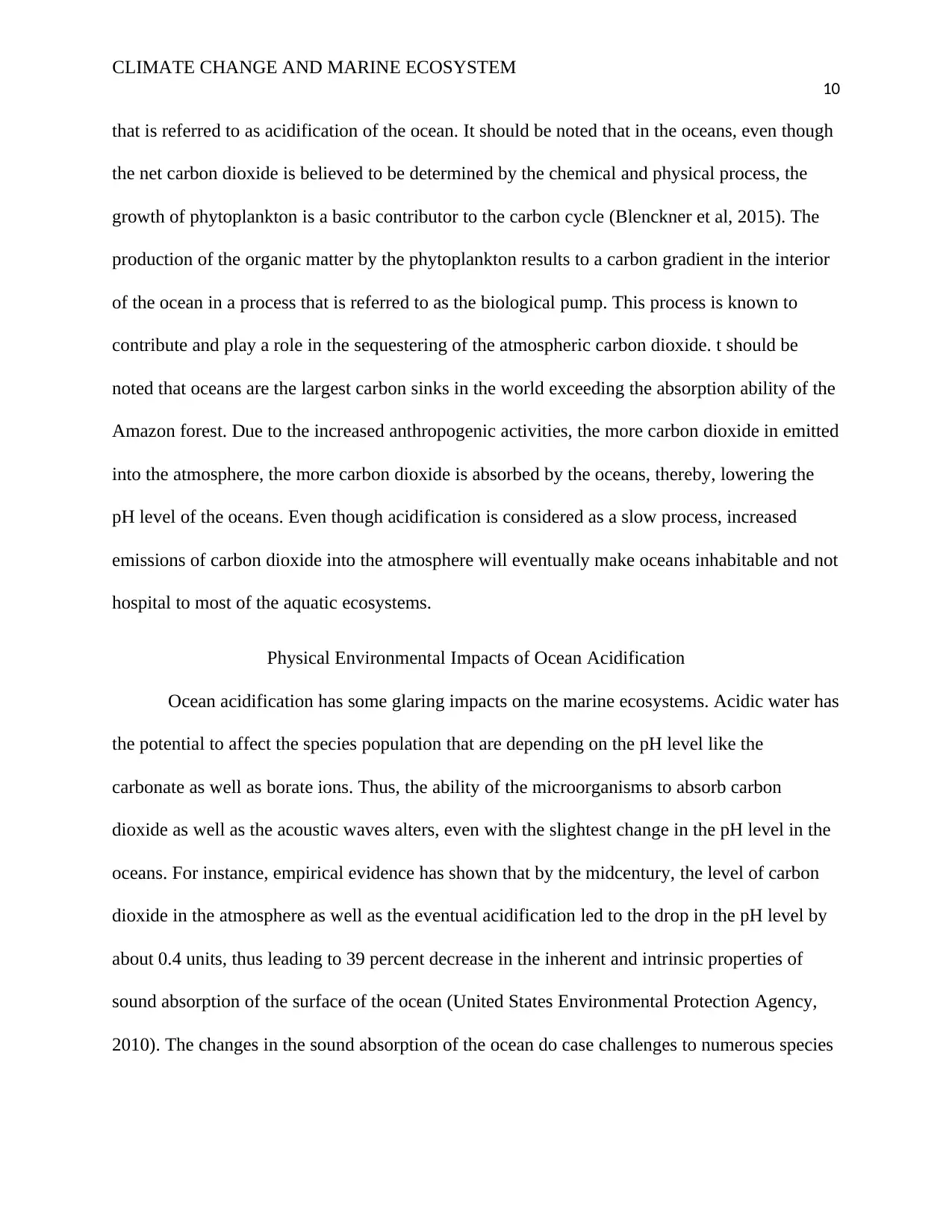
CLIMATE CHANGE AND MARINE ECOSYSTEM
10
that is referred to as acidification of the ocean. It should be noted that in the oceans, even though
the net carbon dioxide is believed to be determined by the chemical and physical process, the
growth of phytoplankton is a basic contributor to the carbon cycle (Blenckner et al, 2015). The
production of the organic matter by the phytoplankton results to a carbon gradient in the interior
of the ocean in a process that is referred to as the biological pump. This process is known to
contribute and play a role in the sequestering of the atmospheric carbon dioxide. t should be
noted that oceans are the largest carbon sinks in the world exceeding the absorption ability of the
Amazon forest. Due to the increased anthropogenic activities, the more carbon dioxide in emitted
into the atmosphere, the more carbon dioxide is absorbed by the oceans, thereby, lowering the
pH level of the oceans. Even though acidification is considered as a slow process, increased
emissions of carbon dioxide into the atmosphere will eventually make oceans inhabitable and not
hospital to most of the aquatic ecosystems.
Physical Environmental Impacts of Ocean Acidification
Ocean acidification has some glaring impacts on the marine ecosystems. Acidic water has
the potential to affect the species population that are depending on the pH level like the
carbonate as well as borate ions. Thus, the ability of the microorganisms to absorb carbon
dioxide as well as the acoustic waves alters, even with the slightest change in the pH level in the
oceans. For instance, empirical evidence has shown that by the midcentury, the level of carbon
dioxide in the atmosphere as well as the eventual acidification led to the drop in the pH level by
about 0.4 units, thus leading to 39 percent decrease in the inherent and intrinsic properties of
sound absorption of the surface of the ocean (United States Environmental Protection Agency,
2010). The changes in the sound absorption of the ocean do case challenges to numerous species
10
that is referred to as acidification of the ocean. It should be noted that in the oceans, even though
the net carbon dioxide is believed to be determined by the chemical and physical process, the
growth of phytoplankton is a basic contributor to the carbon cycle (Blenckner et al, 2015). The
production of the organic matter by the phytoplankton results to a carbon gradient in the interior
of the ocean in a process that is referred to as the biological pump. This process is known to
contribute and play a role in the sequestering of the atmospheric carbon dioxide. t should be
noted that oceans are the largest carbon sinks in the world exceeding the absorption ability of the
Amazon forest. Due to the increased anthropogenic activities, the more carbon dioxide in emitted
into the atmosphere, the more carbon dioxide is absorbed by the oceans, thereby, lowering the
pH level of the oceans. Even though acidification is considered as a slow process, increased
emissions of carbon dioxide into the atmosphere will eventually make oceans inhabitable and not
hospital to most of the aquatic ecosystems.
Physical Environmental Impacts of Ocean Acidification
Ocean acidification has some glaring impacts on the marine ecosystems. Acidic water has
the potential to affect the species population that are depending on the pH level like the
carbonate as well as borate ions. Thus, the ability of the microorganisms to absorb carbon
dioxide as well as the acoustic waves alters, even with the slightest change in the pH level in the
oceans. For instance, empirical evidence has shown that by the midcentury, the level of carbon
dioxide in the atmosphere as well as the eventual acidification led to the drop in the pH level by
about 0.4 units, thus leading to 39 percent decrease in the inherent and intrinsic properties of
sound absorption of the surface of the ocean (United States Environmental Protection Agency,
2010). The changes in the sound absorption of the ocean do case challenges to numerous species
Paraphrase This Document
Need a fresh take? Get an instant paraphrase of this document with our AI Paraphraser

CLIMATE CHANGE AND MARINE ECOSYSTEM
11
like the whales which depend on the sound waves in order to interact and communicate with
each other.
Acidification of the ocean has the influence to cause changes in the light features of the
oceans due to alterations in the concentrations of the calcium carbonate. It should be noted that
trajectory as well as the scattering of light waves in the oceans is caused by concentration of
calcium carbonate. In a case where the ocean is decalcified, the lowered attenuation of light may
lead to deeper and longer euphotic zones; the basic regions in the oceans where primary
production of food takes place. Thus, extending the euphotic zones has the impact on the
biogeochemical nature of the oceans. Increasing range of photosynthesis as well as ocean
acidification can alter the associations between the microorganisms in water and the metals.
Empirical research has shown that reduction in carbonate and hydroxide in the oceans due to
increased carbon dioxide as well as the reduced pH has the impact on the absorption, redox
processes, toxicity and the solubility of metals in the oceans.
Biological Implication of Acidification
The biological consequences of marine acidification are severe and intricate. The major
focus on most scientific researches has been on the impacts of the microorganisms that need
calcium in order to form skeletal and shell structure. In the process of carbon dioxide absorption
in the oceans, the absorbed carbon dioxide mixes with ocean water to form carbonic acid that
subsequently decreases carbonate concentration. The decreased pH level in the oceans have the
impact on the concentration of aragonite and calcite saturation (Gooding, 2009). In areas of the
ocean where the water is undersaturated, the concentration of aragonite and calcite are easily
dissolved inhibiting the formation calcium carbonate. In the saturation horizons, become shallow
due to the increased concentration of the carbon dioxide. The shoaling progression due to the
11
like the whales which depend on the sound waves in order to interact and communicate with
each other.
Acidification of the ocean has the influence to cause changes in the light features of the
oceans due to alterations in the concentrations of the calcium carbonate. It should be noted that
trajectory as well as the scattering of light waves in the oceans is caused by concentration of
calcium carbonate. In a case where the ocean is decalcified, the lowered attenuation of light may
lead to deeper and longer euphotic zones; the basic regions in the oceans where primary
production of food takes place. Thus, extending the euphotic zones has the impact on the
biogeochemical nature of the oceans. Increasing range of photosynthesis as well as ocean
acidification can alter the associations between the microorganisms in water and the metals.
Empirical research has shown that reduction in carbonate and hydroxide in the oceans due to
increased carbon dioxide as well as the reduced pH has the impact on the absorption, redox
processes, toxicity and the solubility of metals in the oceans.
Biological Implication of Acidification
The biological consequences of marine acidification are severe and intricate. The major
focus on most scientific researches has been on the impacts of the microorganisms that need
calcium in order to form skeletal and shell structure. In the process of carbon dioxide absorption
in the oceans, the absorbed carbon dioxide mixes with ocean water to form carbonic acid that
subsequently decreases carbonate concentration. The decreased pH level in the oceans have the
impact on the concentration of aragonite and calcite saturation (Gooding, 2009). In areas of the
ocean where the water is undersaturated, the concentration of aragonite and calcite are easily
dissolved inhibiting the formation calcium carbonate. In the saturation horizons, become shallow
due to the increased concentration of the carbon dioxide. The shoaling progression due to the

CLIMATE CHANGE AND MARINE ECOSYSTEM
12
acidification has the potential to cause susceptibility of the oceans (Edwards & Richardson,
2004).
Even though organisms which are calcified have are likely to suffer the consequences of
ocean acidification, numerous populations of fish and the economies which are based on fishery
will be greatly affected (Held, 2009). The impacts of acidification on the calcified organisms
have the potential to affect markets relying on such organisms like sea urchins, crabs, oysters and
the clams. On the other hand, too much concentration of carbon dioxide in the oceans have the
accelerate the process of acidosis in marine organisms’ tissues leading to hypercapnia in most
fish in the oceans.
Calcification of the Oceanic Organisms
Alterations in the carbon chemistry in the oceans are projected to lead to a decrease in the
process of calcification since carbonate ions are the main elements of calcium carbonate shells of
coral reefs as well as other microorganisms in the oceans (Molen et al, 2013). The calcification
of the coral reefs happens when there is a combination of the calcium ions with carbonate ions as
well as when carbon dioxide absorbed in the oceans exceeds the oceanic buffering capacity.
When such mentioned process occurs, the concentration of carbonate ions reduces inhibiting
coral skeleton production (Kleypas and Langdon, 2006). When carbonic acid is formed through
the absorption of carbon dioxide, the hydrogen protons are normally released combining with the
carbonate ions to form bicarbonate ions. Hydrogens ions combine with the carbonic acid making
the volume of the carbonate ions in the oceans to be less for calcification of the organisms.
The chemical equation for the process is described below;
Calcium carbonate →calcium ions + carbonate ions
12
acidification has the potential to cause susceptibility of the oceans (Edwards & Richardson,
2004).
Even though organisms which are calcified have are likely to suffer the consequences of
ocean acidification, numerous populations of fish and the economies which are based on fishery
will be greatly affected (Held, 2009). The impacts of acidification on the calcified organisms
have the potential to affect markets relying on such organisms like sea urchins, crabs, oysters and
the clams. On the other hand, too much concentration of carbon dioxide in the oceans have the
accelerate the process of acidosis in marine organisms’ tissues leading to hypercapnia in most
fish in the oceans.
Calcification of the Oceanic Organisms
Alterations in the carbon chemistry in the oceans are projected to lead to a decrease in the
process of calcification since carbonate ions are the main elements of calcium carbonate shells of
coral reefs as well as other microorganisms in the oceans (Molen et al, 2013). The calcification
of the coral reefs happens when there is a combination of the calcium ions with carbonate ions as
well as when carbon dioxide absorbed in the oceans exceeds the oceanic buffering capacity.
When such mentioned process occurs, the concentration of carbonate ions reduces inhibiting
coral skeleton production (Kleypas and Langdon, 2006). When carbonic acid is formed through
the absorption of carbon dioxide, the hydrogen protons are normally released combining with the
carbonate ions to form bicarbonate ions. Hydrogens ions combine with the carbonic acid making
the volume of the carbonate ions in the oceans to be less for calcification of the organisms.
The chemical equation for the process is described below;
Calcium carbonate →calcium ions + carbonate ions
⊘ This is a preview!⊘
Do you want full access?
Subscribe today to unlock all pages.

Trusted by 1+ million students worldwide
1 out of 23
Related Documents
Your All-in-One AI-Powered Toolkit for Academic Success.
+13062052269
info@desklib.com
Available 24*7 on WhatsApp / Email
![[object Object]](/_next/static/media/star-bottom.7253800d.svg)
Unlock your academic potential
Copyright © 2020–2025 A2Z Services. All Rights Reserved. Developed and managed by ZUCOL.




